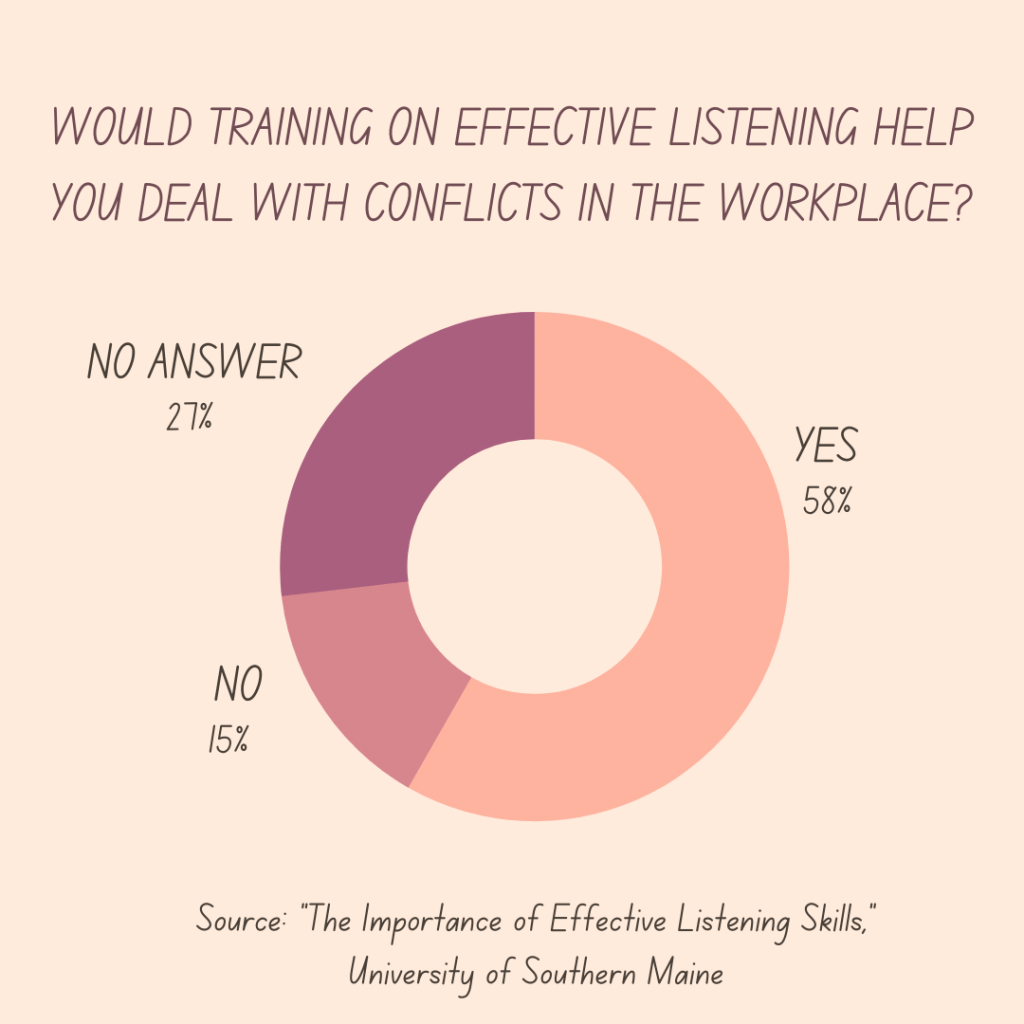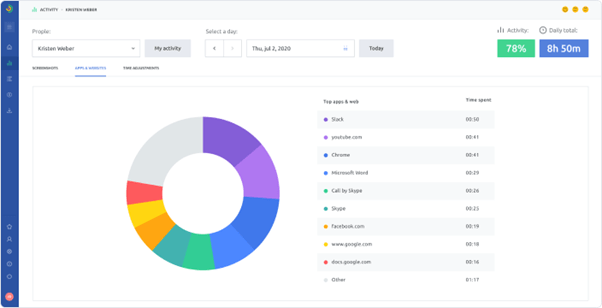
Good communication is everything. It can make a huge difference in an office, organization, or home. Co-workers depend on it to become productive. In fact, a McKinsey study revealed that well-connected teams were more productive by 20 to 25 percent.
Good listening can lead to fewer mistakes, improved productivity, and customer satisfaction. However, for there to be effective communication there has to be active listening.
In today’s world, technology and automation are at the forefront of almost everything we do. Amidst all that, we seem to forget one key aspect in effective communication – the power of active listening.
What Is Active Listening?

So, what exactly does active listening mean?
M. Scott Peck, the author of bestselling book, The Road Less Traveled, describes it best:
“You cannot truly listen to anyone and do anything else at the same time.”
Active listening is when you are ‘fully present’ and aware of what is being said. You are demonstrating that you understand what the other person is trying to say. When you are actively listening, you stop trying to multitask. Instead, you focus on what the other person says rather than passively hearing what he’s trying to convey.
“Discover why this essential communication skill is crucial for fostering collaboration, resolving conflicts, and building strong relationships among team members. With Traqq’s insights, explore the benefits of active listening and learn how to cultivate this skill to enhance your professional effectiveness.”
The main goal of active listening is to pay attention, acquire information, truly comprehend what’s being said. It involves reflecting on the intentions before responding. Active listening is what enables us to form meaningful and lasting relationships in and out of the office.
The thing is, what most of us think is genuine listening is not. Active listening is a technique that needs to be learned and practiced. It needs to be consciously and experientially taught. Moreover, the study further suggests planning and preparing the teaching experience carefully.
As Mortimer Jerome Adler writes in his book, How to Speak, How to Listen:
“We all realize that the ability to read requires training…the same would appear to be true of speaking and listening … training is required … Likewise, skill in listening is either a native gift or it must be acquired by training.”
Developing active listeners in the workplace involves work, not only from the employees but also from the management team.
The Three Levels of Listening
In leadership and management, effective listening is at the heart of everything you do. While it takes patience and practice, once you develop the skill, you will have the advantage over every situation.
Now, to fully comprehend the power of listening, you must first understand the three levels of listening and how they affect your interactions.
Level 1: Internal Listening – Listen to Speak
Internal speaking entails listening to your inner voice, and most of us are stuck at this level. Instead of really listening to others when they speak, we are mostly thinking about what the response will be.
Our response is mostly influenced by our thoughts and emotions rather than trying to understand the perspective of the speaker. Additionally, our minds are preoccupied with other distractions and we don’t make a conscious effort to stop them.
This level of listening is the lowest and comes naturally to most of us. It may lead to misunderstandings and usually cause us to miss the key information in conversations. It also brings the dangers of relativism, which is the foundation of sophistry.
By following the philosophy of “man is the measure of all things,” people end up looking for the subjective truth instead of the objective truth in discussions. Of course, this defeats the purpose of the pursuit of effective communication.
Level 2: Focused Listening – Listen to Hear
In focused listening, we listen intently to what the other person has to say. We actively pay attention to what is being said and to the words. At this level, we may be influenced by our own thoughts, but we make conscious efforts to block them out and focus on the person talking.
We also don’t allow our minds to be distracted by other things. We can get to this level if we are motivated by the situation or by the person speaking. For instance, in a job interview, you listen intently to the questions being asked so that you give the appropriate answers. Your motivation here is your interest in getting the job.
For effective communication, a leader must listen intently to every person, regardless of their employment level. As a leader, this will show that you care about them. You’d be glad to know that a University of Iceland study found that managers who are skilled in active-empathic listening positively affect their employees’ involvement and enthusiasm at work.
Level 3: Global Listening – Listen to Understand
The highest level of the three, global listening involves being genuinely attentive to what the other person says. It also entails analyzing what they mean to say. Not only do we listen to what the other person has to say, but we do so in the context of their surroundings.
In this level of listening, we also start to take notice of non-verbal communication like body language and facial expressions. It also includes other subtle cues like tone, emotions, honesty, and reluctance to share information.
Getting to this level is not easy and requires intentional practice. When practiced well, it can play a major role in decision-making. It also helps build trust between you and employees and establish strong bonds that will boost performance and productivity in teams.
Six Key Elements of Active Listening

To learn active listening, try to practice the following key elements:
1. Pay Attention to What Is Said
Try to fully focus on the speaker. Face the speaker and give him your undivided attention. Most importantly, don’t be the cause of distraction. Avoid playing with your pen or looking at your watch, phone, or other people. Don’t get distracted by activities in and beyond the room.
2. Pay Attention to What Is NOT Said
Words convey only a fraction of the message, so try to develop strong attention to detail skills. When listening, always pay attention to the body language of the speaker. The tone and cadence in his voice can tell you so much about what he’s not saying. Try to detect expressions like boredom, irritation, and enthusiasm. These cues are absolutely important in any conversation and they carry so much meaning.
3. Show Interest
Use your body language to show the other person that you’re listening keenly to him. Use short verbal acknowledgments like “and,” “mm-hmm,” “uh-huh,” and “then.” Encourage the speaker to keep talking. You can also smile and nod to show that you’re hooked. Avoid crossing your arms and instead ensure that your posture is open and inviting. Avoid interrupting them unnecessarily and imposing your own solutions.
4. Give Feedback
Try to summarize what you hear and ask questions to check if you truly understand what they mean. The goal is to prove to the speaker that you’re listening and following his train of thought. Occasionally, paraphrase to get the clear content of the message.

5. Don’t Be Judgmental
Keep an open mind and don’t jump to conclusions. Don’t be thinking to yourself, “Well, that was a stupid thing to do.” When you allow your mind to be judgmental, you will compromise your effective listening capabilities and your response won’t be honest. View the conversation from the speaker’s perspective and don’t make assumptions.
6. Respond Rationally
When the speaker is done speaking and you are confident you’ve fully understood what they mean, it is time to communicate your response. When you do, pay attention to your responses. Respond honestly with the appropriate tone, but be respectful so as not to appear as if you’re attacking him verbally. Treat the speaker as you’d want to be treated.
In active listening, asking questions eliminates misunderstandings and ensures that you get what the speaker means correctly. You can repeat or paraphrase the message to make sure you get their point of view. For instance, you can tell the speaker… “I’m not sure I follow, but…”, “Listening to you, it seems like…”.
The Importance of Active Listening in the Workplace
Lee Iacocca, former president and CEO of Chrysler Corporation, said:
“Business people need to listen at least as much as they need to talk. Too many people fail to realize that real communication goes in both directions.”
Upper-level workers are not the only ones who know the importance of active listening in the workplace. An organizational study submitted to the University of Southern Maine revealed that employees want to be trained in effective communication. They see it as a tool for dealing with difficult people and conflicts in the workplace.

Some of the benefits of active listening in an organization include:
Employee Retention
Active listening plays a key role in employee retention. When employers fail to truly listen to their employees, they risk losing them. If an employee feels like his inputs are being ignored, he will most likely feel resentment towards his job or boss. Chances are high he will seek a job elsewhere. An organization that encourages active communication among the workers and between the workers and management has a greater employee retention rate.
Improved Productivity
To establish a healthy workplace culture and improve the productivity of workers at all levels, active listening is necessary. A team leader or manager should learn to actively consider the views of everyone equally and offer proper feedback. On top of that, acknowledging that communication is a two-way process will foster a culture of mutual trust and understanding.
Pro Tip: Manage Communication with a Time Tracker
Indeed, the constant interaction between colleagues will foster a healthy and productive environment in the workplace. There are also plenty of collaboration tools that help facilitate communication between employees. However, when overly done, these interactions may end up becoming distractions.

As such, we recommend managing communications by using an employee time tracker like Traqq. This program monitors the apps your employees use along with the websites they visit. It also shows you how much time they spend on certain activities. So, you can easily know if people’s excessive time on team chat apps is affecting their productivity.
Strong Workplace Relationship

When employees feel comfortable voicing their ideas and opinions, they can build strong bonds. Active communication reduces the chances of misunderstandings, which could lead to resentment. With positivity filling the working environment, employees will stay focused on completing projects and accomplishing organizational goals.
Active Listening Examples
Try open-ended questions like “You seem very upset by Arby’s reproach. What alternatives have you thought about that could end this resentment?” “You seem hurt by John’s comments. What do you think he’d have done differently?”
Make short verbal affirmations – “Thank you for your concerns. It was nice of you to bring that to my attention.”
Asking direct questions – “How long did you work in your former organization?”
Show interest – “I can relate to what you’re going through.” “I know you’re in a tight spot. How are you coping?”
Make the speaker trust you – “Is there anything I can do to make you feel better about our relationship.”
Conclusion
Active listening has become a rare quality in our world today. Listening intently can build trust and rapport, and establish lasting friendships. It’s a skill worth pursuing, not only to build careers but also to save marriages.
Try practicing these tips and you’ll be well on your path to becoming an active listener. Soon, you’ll start to notice positive changes to those around you in your workplace or at home.

